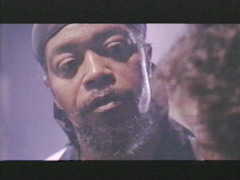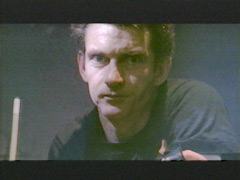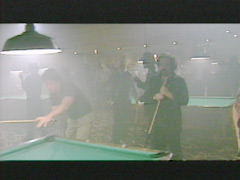

Drinking In Stanislavsky - Street People Make a Film

|
San Francisco--Last year, 138 people without homes died on San Francisco's streets. One of them was a nomadic Vietnam vet who spoke fluent Sioux and called himself Buck. Though he never got the shrapnel out of his skull or the alcohol out of his blood, he did try to find direction in one of the city's more unorthodox recovery programs.
The program, known as the Tenderloin Action Group, was founded in August 1991 by Rob Nilsson, a local film maker, and it invited anyone to act his way off the streets. Within a year, it had grown into a grass-roots workshop that today is finishing a feature film, "Chalk," a smoky pool-hall drama about a small-time hustler set up for a game he cannot win. Mr. Nilsson hopes that the film, which will cost just under $100,000 to make, will be ready for release late this year.
With its unlikely ensemble of novices, "Chalk" is not merely a low-budget melange of "The Hustler," "The Color of Money" and "Mean Streets." Rather, it is a film wrought with detail from the biographies of its cast and dialogue in their own idiom, Mr. Nilsson and his co-writer, Don Bajema, created each character with a workshop member in mind, grafting material from their improvised scenes and their own lives.
The cast might seem a sampling from a census of America's dispossessed, including some people who once led stable, middle-class lives. But to Mr. Nilsson, 52, they are "drifters and dreamers who shared the same conundrums of heart and head that confront us all." Having veered away from home and family to face battles with drugs, alcohol and the streets, these actors discovered a sanctuary in the Tenderloin Group. True, few among them were ever mere bundles on the sidewalk, but fewer still required any makeovers, costume changes or De Niroesque stints on skid row to assume their roles.
Mr. Nilsson, a graduate of Harvard and the Peace Corps, traveled his own odyssey to make "Chalk." Nearing 50 as the 1980s closed, he was no longer up and coming. His independent films had garnered praise from Francis Ford Coppola and John Cassavetes and awards in Cannes (for "Northern Lights" in 1979) and Park City, Utah (for "Heat and Sunlight" in 1988). Despite his early acclaim, the director was shunned by Hollywood and forced to distribute five of his six films on his own. (The exception was the 1985 drama "On the Edge," which starred Bruce Dern.) The decade had made him thinner and grayer, a sinewy cross between Chet Baker and Clint Eastwood.
Mr. Nilsson spent the 80s practicing his own guerrilla film making, which he calls direct action cinema. It is modeled, he confesses with obvious adulation, on the cinema verite of Cassavetes. Emphasizing improvisation and character over strict plot lines and big-budget effects, he had lionized the struggles of Norwegian farmers, San Francisco cabbies, a disgraced runner and lovers in the final hours of an affair. But he had yet to touch a subject that haunted him daily.
That subject was his younger brother, Greg. For 10 years he had searched for Greg, who had left the family's home in Marin County and begun wandering around the country. By the spring of 1989, the breadlines in the city's Tenderloin district, seething with the down and out, had filled its seamy sidewalk. Every morning, on his way to edit "Heat and Sunlight," Mr. Nilsson would scan the hungry faces in search of Greg's. "About twice a year," he recalls, "my dad would get a call from some hospital in South Carolina or somewhere: 'We've got your son here. What should we do?'" Mr. Nilsson, too, wondered what he could do.

|
On the set of "Chalk," it is obvious he has found his answer. "This film's not about homelessness," he makes clear, "but it evolved out of my desire to address the issue." In the summer of 1991 Mr. Nilsson moved across the bay from Berkeley, where he lives, into a transient hotel in the Tenderloin, where he spent months writing a script called "Hope for the Fourth Ace."
"It's about a Vietnam vet and his lottery card that has four scratch-off numbers. A game of reverse Russian roulette." Mr. Nilsson shopped it around furiously, even paying his own way to Cannes, only to be "killed with kindness, not offers." Realizing that the homeless were not likely to attract audiences in the recession, he recruited Danny Glover and Whoopi Goldberg to work for scale. "Then James Olmos, Sally Kirkland and Peter Coyote volunteered," he says. While still hunting for the $4 million needed for financing, Mr. Nilsson and his co-producers, Rand Crook and Ethan Sing, searched for an "auxiliary cast," advertising a free acting workshop for anyone in San Francisco shelters. Each workshop was videotaped.
"That raw footage was bottled lightning," Mr. Nilsson says. "It was a collective human cry. You know why you see guys screaming on the street? Because they're wound up so tight. Give them a chemical twist, and a spigot opens." Offering nothing stronger than diluted Stanislavsky, Mr. Nilsson pulled together the makings of a film.
"It struck me one day," he recalls: "Don't wait for the money. Use video. Turn the warehouse into a pool hall and use these wonderful actors." And so, with four donated pool tables, a bar built by the cast, nearly $25,000 from benefits whose attractions were names like Tom Waits, Gregg Allman and Gena Rowlands, and a $6,500 check from a "local angel," shooting began last June.
Ten months earlier, the Tenderloin Action Group had met for the first time. "That night we were just a brave few, fresh from the streets," remembers Edwin Johnson, who plays Watson, the proprietor of the hustler's local pool hall. Strangers on the streets, they discovered in the workshop that they shared painful histories.
"We're all just folks who ran across hard times," says Sharon Jamieson, a thirtysomething graduate of the University of the District of Columbia who spent six months in shelters before joining the Tenderloin Group. Motivated mostly by curiosity, the homeless trickled down down to the organization's headquarters, a leaky warehouse in the city's industrial area.
Once a week, nearly two dozen would-be thespians came together. Ms. Jamieson recalls her elation after the first workshop: "It nourished my soul. I'm not saying I'm gonna be another Whoopi in six months, but it gave incentive to wean myself off the streets."
Few of the participants had acted before. Destiny Costa, a 21-year-old with a history of both alcohol and drug abuse, had been a witch/tour guide" in a Salem, Mass., museum. Ms. Jamieson had been an extra in "White Men Can't Jump" and "The Mambo Kings."

|
Mr. Nilsson, it turned out, was spared searching the Tenderloin for his brother. Greg resurfaced and has a small role in "Chalk" as the pool hall's custodian.
Like Greg, many in the cast have found not only an audience but a family. "On the streets," explains Edwin Johnson, "you know a lot of people. But not one can you call a friend." Although their part-time work on "Chalk" is unpaid pending a distribution deal, many members of the Tenderloin Group have found their lives change. Disdaining alcohol and drug abuse, and becoming accustomed to keeping a schedule, they have now managed to find jobs and, at the least, rooms of their own.
"Chalk" has also proved to be an esthetic adventure. "I wanted to let them mine their experiences and emotions," Mr. Nilsson says. "There was a lot of kindergarten rote reading at first, so we just found another skein to travel along." The director was careful to guide his actors away from self-indulgence, toward self-exploration. "Rob's different with each of us," Ms. Costa says. "He may be teacher, mentor, brother or father. But he gets us all to open up."
Mr. Nilsson's evolving role falls uneasily on his shoulders. "I'm not an acting teacher," he says. "I trust feeling over acting. My just is just a bit of midwifery."
Yet with an anthropologist's allegiance to authenticity, he kept his writerly impulses out of the script. "People on the street talk like no one could ever write," Mr. Nilsson says, quoting one of the Buck's mantras: "Ain't no woman gonna bleed my best thoughts."
The director concedes that in the move from the workshop to the film, "a few got away." One was Neil, by all accounts a natural leading man, but a heroin addict unable to shake the habit.
Though Neil remains in the film in a smaller role, his departure forced Mr. Nilsson and Mr. Bajema into a major rewrite. "I cast one of Chalk's two professionals, Kelvin Han Yee; and our African-American lead suddenly became Asian," Mr. Nilsson says. And filming began on schedule.
Mr. Nilsson is determined to screen "Chalk" nationwide as a testament to his cast. (A New York distributor, Arrow Entertainment, has expressed interest in the rights.) For Mr. Nilsson, the workshop is not enough. "This is not about process," he insists. "I'm an artist. I believe in leaving an artifact behind."
The New York Times, Arts & Leisure, February 14, 1993